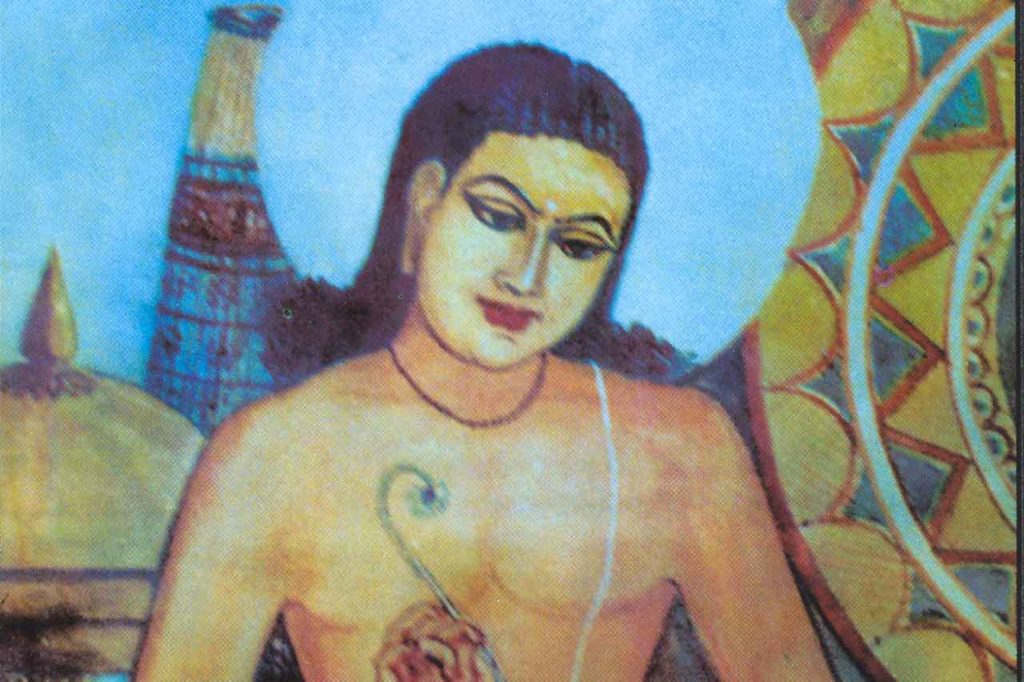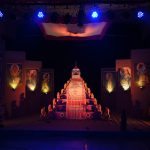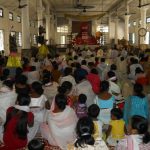Srimanta Sankaradeva (1449-1568) was a multi-faceted genius, who has hardly any equal in the annals of human history. He is generally known as a religious preceptor, litterateur, and cultural maestro. But he was more than that. He was a good planner and innovator. He evolved a new management style through his socio-cultural-religious innovations. His handling of people led to the development of a new approach in Human Resource Management. Heterogenous people came together and stayed together under his banner because of his Team Management and Feedback Management. He evolved his own style of Project Management. He showed the world about how to do Conflict Management. He trained a group of dedicated disciples and made them future leaders by his Decentralised Leadership Management. He imparted his unmatched knowledge among the teeming masses through his innovative Knowledge Management. In the present paper we will however highlight the human resource management.
Srimanta Sankaradeva lived in a time marked by severe stress that thwarted any scope of originality or innovation. Yet he succeeded in creating his own space and leaving a permanent legacy for the entire mankind. His contribution to the Assamese society was only incidental. In fact the Assamese society was instrumental to reach unto the entire humanity. He was a perfect global citizen, because he never addressed the Assamese people but addressed the entire humanity. Moreover he always refrained from criticising any one believing in any other concept that was at variance form his own. Such a liberal attitude is unheard of in the medieval era he lived in and this itself qualifies him as a human resource manager very easily. The neutrality seen in Srimanta Sankaradeva is not academic, but fully practical and realistic. He taught tolerance, the basic ingredient of civilization, to a conglomerate of intolerant ethnic groups.
Srimanta Sankaradeva devolped a scalable architecture in the course of his socio-cultural-religious activities. The implicit idea was to give a distributed architecture to make it more accommodative to a conflicting heterogenous social structure at that time. There were many variables obstructing his works, but he had an indomitable spirit to surmount all those. He did not allow those social variables to constrict the growth of his new order and his new culture. Scalable Distributed Data Structure (SDDS) is a complete enough environment offering a set of functions to manage and access information distributed in a computer network. In Srimanta Sankaradeva’s case, such a computerised regression model with multi-variables can be constructed with explanatory variables like geo-locational factor, cultural resource factor, hereditary factor, social opposition factor etc. Some dummy variables like political factor, economic income factor etc also will have to be taken to solve such a model in quantitative manner as such explanatory variables were not uniformly present in all situations. There would certainly be a time lag factor in this function and hence there will be several lagged variables in the entire data structure. The basic equation of the function may be like
Y = α + α1D1 + α2D2 + α3D3 + β1X1 + β2X2 + β3X3 + ……. + βnXn + u
Where Y is dependent variable, α’s and β’s are co-efficients, D’s are dummy variables, X’s are n number of explanatory variables, and u is the disturbance term. The estimates of α’s and β’s will give the scalable distributed data structure for Srimanta Sankaradeva. If we bring in time factor, we can present the X variables in matrix form. If the impact of the variables extend to r time-periods, we will get a matrix of r x n order. With a single period time lag, the above equation can be presented as
Y = α + α1D1t + α1D1t-1 + α2D2t + α2D2t-1 + α3 D3t + α3D3t-1 + β1X1t + β1X1t-1 + β2 X2t + β2X2t-1 + β3X3t + β3X3t-1 + ……. + βnXnt + βn Xnt-1 + u
If the β co-efficients change over time, this model will change further to become a Polynomial Distributed Lag (PDL) model.
The only major problem in this econometric model lies in quantifying these abstract variables. But that can be done if we prepare a scale for measuring them with reference to the perfect situations in those variables. This is analogous to the grading system in academics. So a gradation system in 10-point scale can take care of quantifying the variables in the above equation.
The most infamous variables at work in the above function were inter-ethnic conflict, opposition by some Brahmin priests, illiteracy of the masses etc. The opposition of the Brahmin priests was explicit in Dhuwahata, Patbausi, and Kochbehar. At Dhuwahata the priests used to snatch away the rosaries from Srimanta Sankaradeva’s disciples and hang them onto dog-tails. In Kochbehar and Ahom capital the Brahmin priests incited the kings against Srimanta Sankaradeva. Naranarayana even declared that he would give Srimanta Sankaradeva’s flesh to dogs.
The examples of ethnic conflicts were those of the Bhuyans with the Kacharis, the Daflas, the Ahoms, etc in places like Bardowa, Rowta, Dhuwahata etc. Srimanta Sankaradeva brought the conflicting tribes of Brahmaputra valley together by working on their positive qualities. This was how he worked in the area of conflict management. People of the Kachari tribe, who considered the Bhuyans as arch-enemies turned to the religious order founded by the saint within a few decades. While Assam history is replete with recurrence of many inter-ethnic conflicts in later periods, there is no instance of any Bhuyan-Kachari conflict in the later period. So the conflict management model pursued by Srimanta Sankaradeva was a successful one.
Decentralized leadership was an important feature of the Eka Sarana Nama Dharma order founded by Srimanta Sankaradeva. There was no dictatorship in this order as commonly seen in many religious orders. The saint involved every one in the decision making process. When he wanted to set out for pilgrimage, he asked the devotees to take that decision and also contribute to their capacity. When the pilgrims reached a crossroads to Vrindavana during the journey, Srimanta Sankaradeva asked them to decide as to whether they should return home from there itself or visit Vrindavana. There were many such instances of such decentralized leadership. Once he decided to send Madhavadeva to upper Assam for preaching the religious ideology there as the devotees living in upper Assam wanted some one there as representative of the saint. But this decision was annuled just a little while later when Narayanadas Thakur protested vehemently saying that the decision to send Madhavadeva to upper Assam would affect the entire order as Madhavadeva was important for the entire order. The decentralized leadership became more pronounced when Madhavadeva, the chosen successor of Srimanta Sankaradeva asked the disciples just before his death to decide the matters of the order thencefrom by discussion among themselves, not by dictation of any one leader. The practice of electing the Sattriya of Barpeta Than came into being as a result of such instruction.
The Decentralised Leadership Management (DLM) is a responsible systematic behaviour to reduce all kinds of leadership corruptions. Responsibilities were not centralized. This approach means seeing all members of the DLM as experts in their own right as uniquely important sources of knowledge, experience and wisdom. It is part of human resource development. Srimanta Sankaradeva was a personification of DLM. He delegated different responsibilities to his disciples. For instance he entrusted the duty of initiating Brahmin devotees to Damodaradeva. He empowered two disciples to initiate others. They were Damodaradeva and Madhavadeva. Once he entrusted the Than management to Damodaradeva when he went on second pilgrimage. There was no parrallel of Srimanta Sankaradeva‘s Than management in the contemporary history. His model of Leadership Management was continued by his next generation leaders Damodaradeva and Madhavadeva. They trained up Gopal Ata, Badula Ata, Bangshi Gopal Ata etc.
Srimanta Sankaradeva inculcated multi-faceted characters in his disciples and developed their all-round personalities. He saw to it that his disciples mastered several art like music, dance, acting in play, making of items like Sanchi-Pat at the same time. The saint was a good motivator. His disciples were encouraged to learn many new things, for which he also made the learning tools easily available for them. In the medieval period the tools of learning were restricted to the upper echelon of the society. But Srimanta Sankaradeva made those available to every one in different forms. He made an elaborate system of Knowledge Management (KM) so that knowledge could be disseminated. The devotees were made to train themselves in the knowledge about the supreme absolute through the multi-media productions of the saint. These included Bargeet, Ankiya plays, hymns, prayer books etc. They were also required to maintain the Kirtanghar as well as the residential quarters in the Than premises. Srimanta Sankaradeva shunned intellectualism devoid of reality. All his disciples were firmly rooted in ground realities.
There was a sort of promotion and performance evaluation system in the order. So we find that performances of Vyaskalai, Udar Govinda, Ram Rai etc were very stringently evaluated when they deviated from the main principles of the order. Their deviations were of different degrees and hence the punitive measures taken also differed. On the other hand, Madhavadeva was highly appreciated several times following excellent performances by him in different matters. The same was true with Narayanadas Thakur, Sri Ram etc. Srimanta Sankaradeva even put in record his appreciation of Ram Rai who successfully sponsored several plays authored by him. His evaluation system was quite unique. He led by perfect example and skilful advice as evident from his regular discourses even while walking during the pilgrimage. He was never commandingly autocratic as is seen in most religious orders; he was gentlemanly democratic, while at the same time being very firm on the main principles.
Democratic governance was the corrollary of the decentralized leadership. The feudal elements generally seen in the religious organisations was not seen in the Thans set up by the saint. Devotees were not charged any fees by the Than for religious services rendered to them. The Thans were designed to be self-sufficient and sustainable. Not only the Than was sustainable, it taught people to be sustainable in life. Than, later known as Satra, gave scope for devotees to learn art, literature, handicrafts etc. Religious tax ‘Gurukar’ was an aberration and it came later. All Thans established by Srimanta Sankaradeva continue to be run by committees elected by devotees. Even the Satras, which are hereditary institutions of selected followers, have gradually adopted this mode of managing their institutions.
Democratic governance requires proper Feedback Management. If the members of a system are allowed to give feedback they identify with that system. Srimanta Sankaradeva realised that and he allowed feedback fully. So even illiterate disciples could address him and communicate with him very casually. He valued the feedback given by his disciples very seriously. All the devotees could communicate with him directly without any intermediary.
Shared support and responsibilites mark the Eka Sarana Nama Dharma order founded by Srimanta Sankaradeva. The devotees perform all works together. Srimanta Sankaradeva stressed on the concept of Team Management (TM). All devotees were like one soul, thanks to the teachings of Srimanta Sankaradeva. Whether preparing offerings in Kirtanghar, preparing costume or dyes for Bhaona, rehearsing for dance recital, the devotees did every thing together. Responsibilities were well-defined in the order. The Than or Satra had devotees earmarked for singing prayer hymns, playing drum, calling devotees to prayer, preparing offerings, distributing Prasada, and so on. This well distributed work allotment made the order systematic. But it was not a hierarchical system, because even high profile devotee like Madhavadeva distributed Prasada when need arose. Srimanta Sankaradeva himself cleaned and washed the floor of Kirtanghar once. So there was enough flexibility in the system. This became possible due to the common inter-personal goals in the order. Srimanta Sankaradeva always emphasised on exploring the points of agreement among the members of the order. Thus he practised all rules of human resource management.
Openness to new ideas was a great merit of the saint. This trait is generally missing in most people because of which they fail to see the perspective of the other people. One has to be open and flexible to manage a heterogenous group of people, which the Eka Sarana Nama Dharma order was. There were people of almost all ethnic groups, all castes. Srimanta Sankaradeva could adjust with all of them because of his flexibility. This quality was seen in other spheres also like commodity production. For instance in textile weaving he easily incorporated a new style of weaving while preparing the famous Vrindavani cloth at the express request of Koch king Naranarayana. That technique of weaving was not in vogue any where in India at that time and certainly not in Assam. So it was a great innovation.
Mutual respect and harmony characterised every step in Srimanta Sankaradeva’s life. He respected individuality of every person. So he did not force his wife Kalindi to accept his religious belief and allowed her to realise it herself. It was only after Kalindi had a discussion with Madhavadeva that she decided to accept Eka Sarana Nama Dharma. What was true within the household was true for the entire order. So every one felt at home in this order. Srimanta Sankaradeva gave respect to every person. The most important example of this was the honour shown to Radhika, a lady from a suppressed community. He not only made her the leader of dam construction work at Tembuwani, but also rehabilitated her family beside his own residence. Such attitude enabled Srimanta Sankaradeva to mobilise people in large number to construct the dam in Tembuwani.
All the above traits of the saint were suitable for the heterogenous society he lived in, where the tribal people comprised the majority. The tribal societies had some of these traits embedded in their traditional societies. For example we can mention the characteristics like decentralized leadership, mutual respect and harmony, shared support and responsibilites, democratic governance etc. So it became easy for them to adjust to the life of Eka Sarana Nama Dharma order. Thus the social life of the then Brahmaputra valley could be easily mapped into the system of Eka Sarana Nama Dharma order. It thus became a smooth transition.
Suggested readings :
Mahapurusha Srimanta Sankaradeva, Dr Sanjib Kumar Borkakoti, Bani Mandir, Guwahati, First edition, 2005
Place of Srimanta Sankaradeva in all India perspective, Dr Sanjib Kumar Borkakoti, Mahapurusha Sankaradeva Kala Krishti Gaveshana Kendra, Jorhat, First edition, 2007
Unique contributions of Srimanta Sankaradeva in religion and culture, Dr Sanjib Kumar Borkakoti, Srimanta Sankardeva Sangha, Nagaon, First edition, 2006
Srimanta Sankaradeva : an epoch maker, Dr Sanjib Kumar Borkakoti, EBH Publishers (India), an imprint of Eastern Book House, Guwahati, First edition, 2012
Purnanga Katha Gurucharit, Dr Sanjib Kumar Borkakoti, Bani Mandir, Guwahati, First edition, 2007
Acknowledgement :
This article was earlier published in the website www.sankaradeva.com




